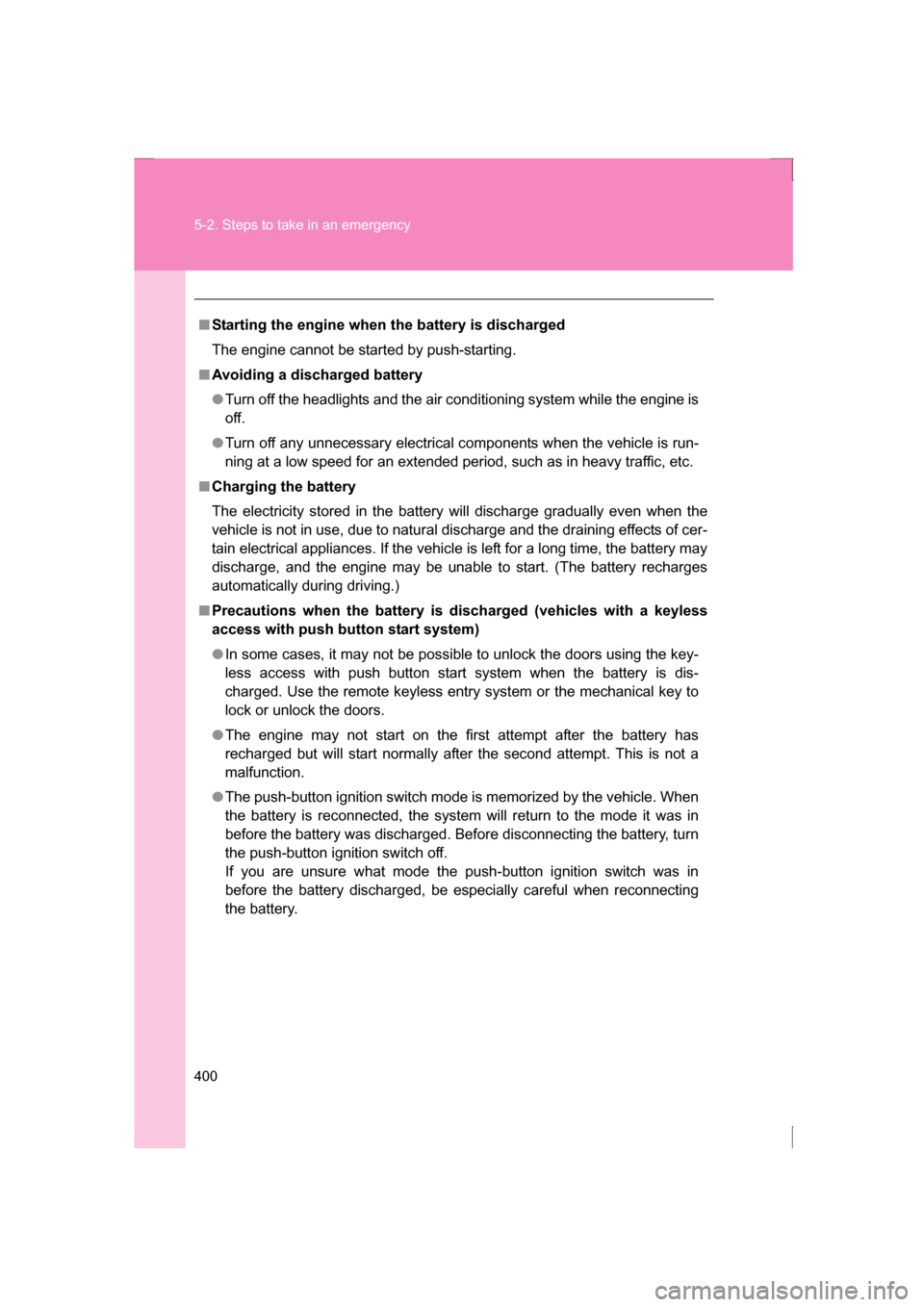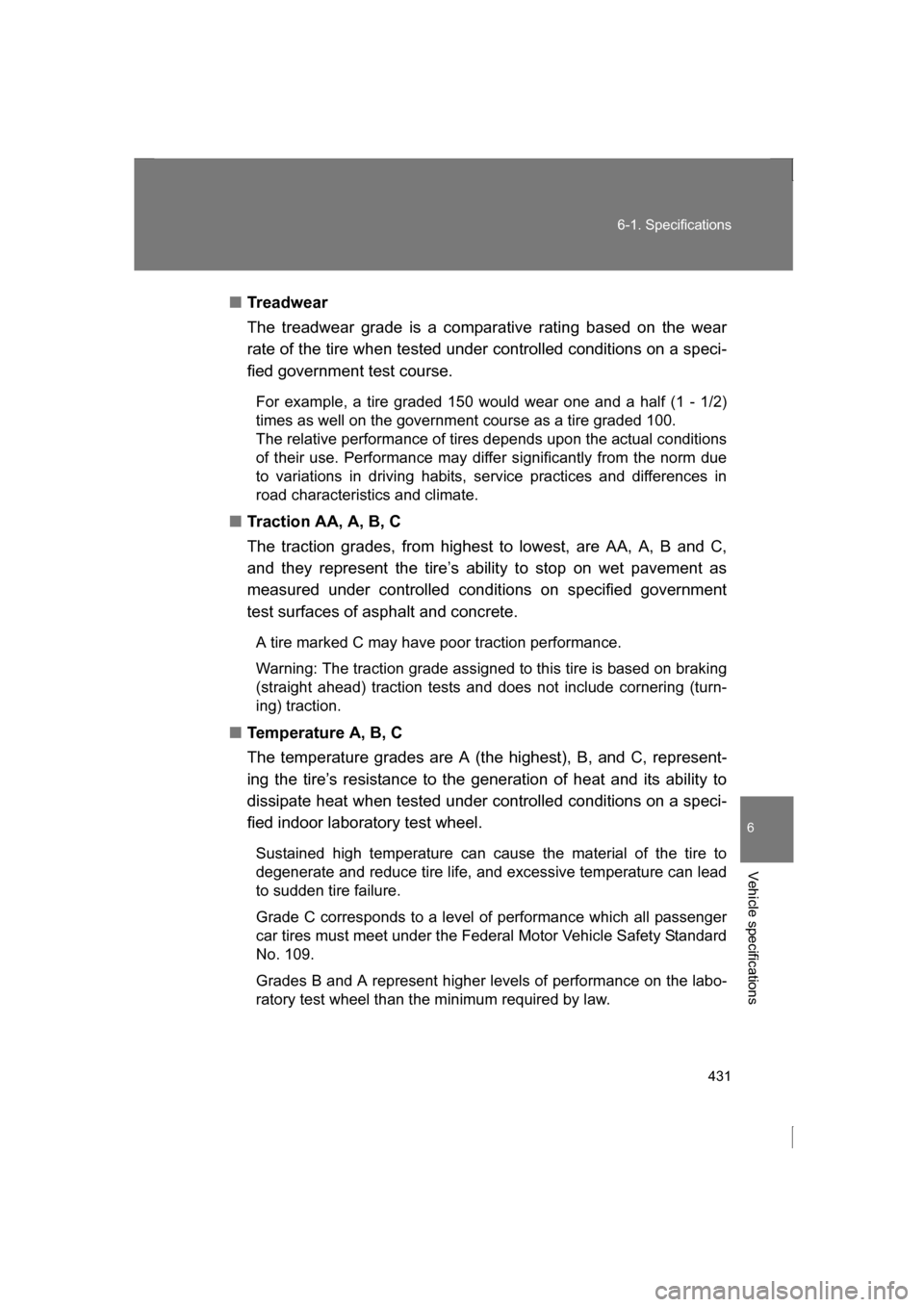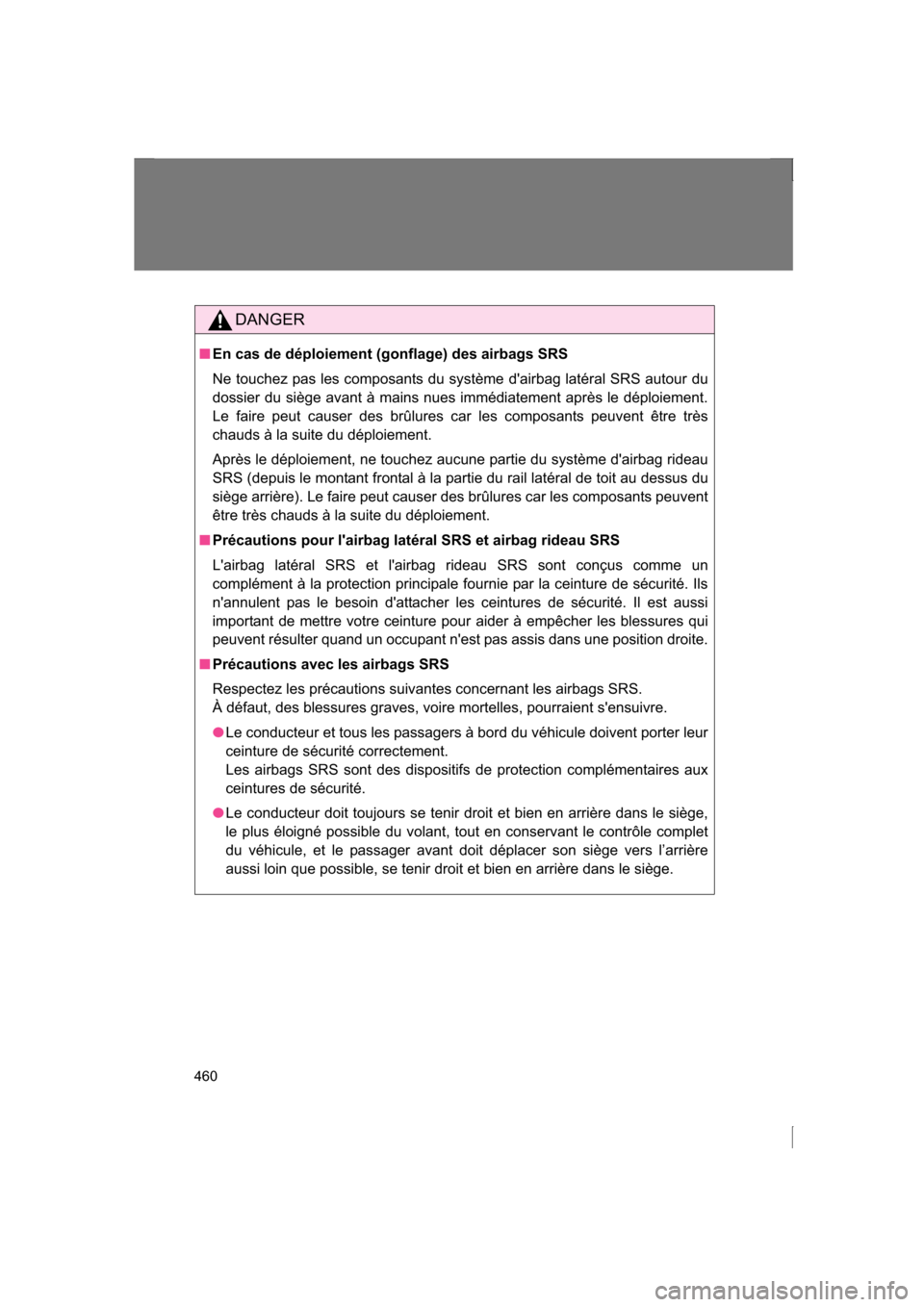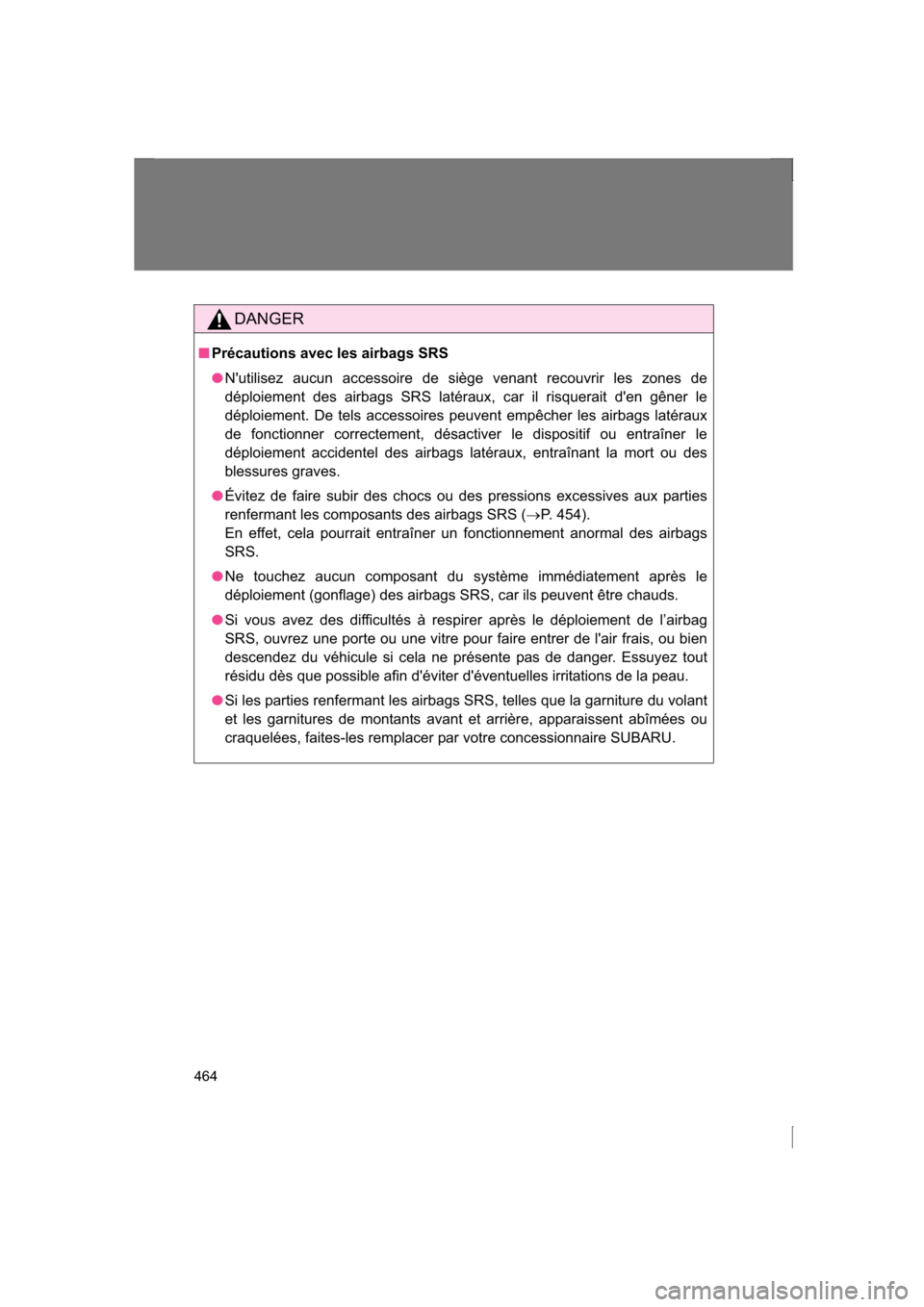Page 400 of 484

400
5-2. Steps to take in an emergency
■Starting the engine when the battery is discharged
The engine cannot be started by push-starting.
■Avoiding a discharged battery
●Turn off the headlights and the air conditioning system while the engine is
off.
●Turn off any unnecessary electrical components when the vehicle is run-
ning at a low speed for an extended period, such as in heavy traffic, etc.
■Charging the battery
The electricity stored in the battery will discharge gradually even when the
vehicle is not in use, due to natural discharge and the draining effects of cer-
tain electrical appliances. If the vehicle is left for a long time, the battery may
discharge, and the engine may be unable to start. (The battery recharges
automatically during driving.)
■Precautions when the battery is discharged (vehicles with a keyless
access with push button start system)
●In some cases, it may not be possible to unlock the doors using the key-
less access with push button start system when the battery is dis-
charged. Use the remote keyless entry system or the mechanical key to
lock or unlock the doors.
●The engine may not start on the first attempt after the battery has
recharged but will start normally after the second attempt. This is not a
malfunction.
●The push-button ignition switch mode is memorized by the vehicle. When
the battery is reconnected, the system will return to the mode it was in
before the battery was discharged. Before disconnecting the battery, turn
the push-button ignition switch off.
If you are unsure what mode the push-button ignition switch was in
before the battery discharged, be especially careful when reconnecting
the battery.
Page 431 of 484

431
6-1. Specifications
6
Vehicle specifications
■Treadwear
The treadwear grade is a comparative rating based on the wear
rate of the tire when tested under controlled conditions on a speci-
fied government test course.For example, a tire graded 150 would wear one and a half (1 - 1/2)
times as well on the government course as a tire graded 100.
The relative performance of tires depends upon the actual conditions
of their use. Performance may differ significantly from the norm due
to variations in driving habits, service practices and differences in
road characteristics and climate.
■Traction AA, A, B, C
The traction grades, from highest to lowest, are AA, A, B and C,
and they represent the tire’s ability to stop on wet pavement as
measured under controlled conditions on specified government
test surfaces of asphalt and concrete.
A tire marked C may have poor traction performance.
Warning: The traction grade assigned to this tire is based on braking
(straight ahead) traction tests and does not include cornering (turn-
ing) traction.
■Temperature A, B, C
The temperature grades are A (the highest), B, and C, represent-
ing the tire’s resistance to the generation of heat and its ability to
dissipate heat when tested under controlled conditions on a speci-
fied indoor laboratory test wheel.Sustained high temperature can cause the material of the tire to
degenerate and reduce tire life, and excessive temperature can lead
to sudden tire failure.
Grade C corresponds to a level of performance which all passenger
car tires must meet under the Federal Motor Vehicle Safety Standard
No. 109.
Grades B and A represent higher levels of performance on the labo-
ratory test wheel than the minimum required by law.
Page 453 of 484
453
7
For owners
DANGER
■Airbag SRS
●N’INSTALLEZ JAMAIS DE SIÈGE DE SÉCURITÉ ENFANT VERS
L’ARRIÈRE DANS LE SIÈGE AVANT. LE FAIRE POURRAIT CAUSER
DES BLESSURES GRAVES VOIRE MORTELLES À L’ENFANT EN
PLAÇANT LA TÊTE DE L’ENFANT TROP PRÈS DE L’AIRBAG SRS.
●N’autorisez jamais un enfant à se tenir debout ou à s’agenouiller dans le
siège passager avant, et ne tenez jamais un enfant sur vos genoux ou
dans vos bras. L’airbag SRS se déploie avec une force considérable et
peut blesser ou même tuer l’enfant.
●Quand l’airbag SRS se déploie, de la fumée se dégage. Cette fumée peut
causer des problèmes respiratoires pour les individus avec des
antécédents d’asthme ou d’autres problèmes respiratoires. Si vous ou vos
passagers avez des problèmes respiratoires après le déploiement de
l'airbag SRS, prenez l'air immédiatement.
●Un airbag SRS qui se déploie dégage du gaz chaud. Les occupants
peuvent être brûlés s'ils sont en contact direct avec le gaz chaud.
Page 460 of 484

460
DANGER
■En cas de déploiement (gonflage) des airbags SRS
Ne touchez pas les composants du système d'airbag latéral SRS autour du
dossier du siège avant à mains nues immédiatement après le déploiement.
Le faire peut causer des brûlures car les composants peuvent être très
chauds à la suite du déploiement.
Après le déploiement, ne touchez aucune partie du système d'airbag rideau
SRS (depuis le montant frontal à la partie du rail latéral de toit au dessus du
siège arrière). Le faire peut causer des brûlures car les composants peuvent
être très chauds à la suite du déploiement.
■Précautions pour l'airbag latéral SRS et airbag rideau SRS
L'airbag latéral SRS et l'airbag rideau SRS sont conçus comme un
complément à la protection principale fournie par la ceinture de sécurité. Ils
n'annulent pas le besoin d'attacher les ceintures de sécurité. Il est aussi
important de mettre votre ceinture pour aider à empêcher les blessures qui
peuvent résulter quand un occupant n'est pas assis dans une position droite.
■Précautions avec les airbags SRS
Respectez les précautions suivantes concernant les airbags SRS.
À défaut, des blessures graves, voire mortelles, pourraient s'ensuivre.
●Le conducteur et tous les passagers à bord du véhicule doivent porter leur
ceinture de sécurité correctement.
Les airbags SRS sont des dispositifs de protection complémentaires aux
ceintures de sécurité.
●Le conducteur doit toujours se tenir droit et bien en arrière dans le siège,
le plus éloigné possible du volant, tout en conservant le contrôle complet
du véhicule, et le passager avant doit déplacer son siège vers l’arrière
aussi loin que possible, se tenir droit et bien en arrière dans le siège.
Page 464 of 484

464
DANGER
■Précautions avec les airbags SRS
●N'utilisez aucun accessoire de siège venant recouvrir les zones de
déploiement des airbags SRS latéraux, car il risquerait d'en gêner le
déploiement. De tels accessoires peuvent empêcher les airbags latéraux
de fonctionner correctement, désactiver le dispositif ou entraîner le
déploiement accidentel des airbags latéraux, entraînant la mort ou des
blessures graves.
●Évitez de faire subir des chocs ou des pressions excessives aux parties
renfermant les composants des airbags SRS (�oP. 454).
En effet, cela pourrait entraîner un fonctionnement anormal des airbags
SRS.
●Ne touchez aucun composant du système immédiatement après le
déploiement (gonflage) des airbags SRS, car ils peuvent être chauds.
●Si vous avez des difficultés à respirer après le déploiement de l’airbag
SRS, ouvrez une porte ou une vitre pour faire entrer de l'air frais, ou bien
descendez du véhicule si cela ne présente pas de danger. Essuyez tout
résidu dès que possible afin d'éviter d'éventuelles irritations de la peau.
●Si les parties renfermant les airbags SRS, telles que la garniture du volant
et les garnitures de montants avant et arrière, apparaissent abîmées ou
craquelées, faites-les remplacer par votre concessionnaire SUBARU.
Page 481 of 484
481
What to do if...
What to do if...
A tire puncturesP. 378If you have a flat tire
The engine does not start
P. 389If the engine will not start
P. 7 7Engine immobilizer system
P. 398If the battery is discharged
The select lever cannot be
moved outP. 392If the select lever cannot be shifted
from P
The engine coolant temper-
ature gauge enters the red
Steam can be seen coming
from under the engine hood
P. 403If your vehicle overheats
The key is lostP. 393If you lose your keys
The battery runs outP. 398If the battery is discharged
The doors cannot be lockedP. 4 2Doors
The trunk cannot be openedP. 4 5Trunk lid
The vehicle is stuck in mud
or sandP. 406If the vehicle becomes stuck
A warning light or indicator
light comes onP. 364If a warning light turns on or a
warning buzzer sounds...